Gan Chris Grinter, ar Ebrill 19eg, 2011
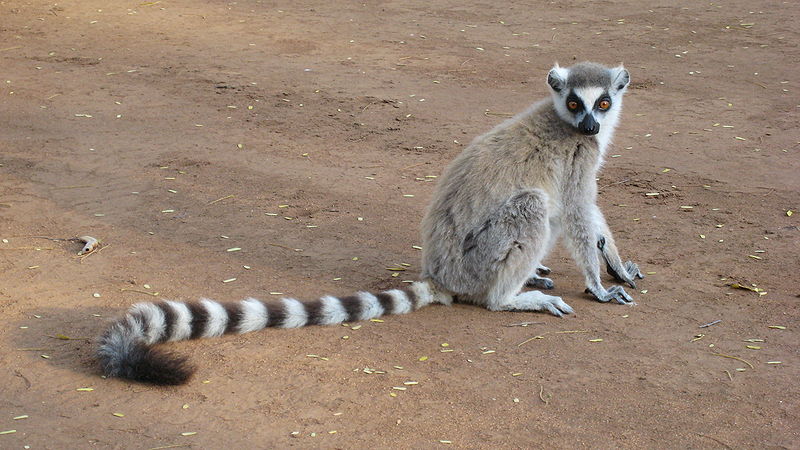 Ffynhonnell: Wikipedia Mae'n ymddangos bod gan Richard Branson syniad newydd; i achub y lemwr cynffonog (Catur lemur) gan importing them to his private British Virgin Island. Fel y mae'r erthygl yn nodi, gwariodd Branson filiynau o bunnoedd a blynyddoedd o ymdrech i droi'r ynys yn “the most ecologically friendly island in the world”. But it appears Mr Branson has decided to forgo conservation science and rewrite it in a more PR friendly way. In come the lemurs despite the cautions of his own ecological assessment because he wants “…to create a second island habitat and the conditions on Moskito are perfect.” Perhaps Branson has a bizarro world dictionary where the definition of the word perfect is “something completely dissimilar from the original”.
OK sure, at first the idea sounds like a fine one – the lemurs are endangered, why not try to give them a second wild refuge? Wel, Dr James Lazell of the Conservation Agency has had 31 years experience in the Virgin Islands and has pointed out that “Lemurs are agile, dexterous, aggressive, omnivorous animals that could have a detrimental effect on these simple island ecologies. They eat absolutely everything – lizards, fruit, roots, pryfed, birds’ eggs.” Oh but don’t worry, nothing bad can happen when you introduce primates to an island (introduced primates devastate Florida Key). Branson knows that the lemurs will only “take the odd gecko” (like the rare endemic dwarf-gecko Sphaerodactylus parthenopion), not to mention they probably won’t spread to other islands since they “hate swimming” (ring tailed lemur swimming).
So why then the ring-tailed? Not because it is the most endangered (Mae yna llawer of other more endangered lemurs), but because it is the most iconic. That is what really drives me up the wall about this ridiculous idea. Not only is he naively introducing a possibly invasive species into a sensitive island habitat – but because he is spreading a false message of conservation. Like a slow child Branson has rushed to the ring-tailed to save it while completely missing the entire idea behind conservation. The ring-tailed is a flagship species, one that draws attention to the devastation that is occurring in Madagascar. One cute cuddly animal to represent the staggeringly unique and diverse habitats of its homeland. But not if Richard Branson has anything to say about it. Why bother protect Madagascar when you can swoop in and create a new home for a primate everyone loves? Phew, crisis averted. Richard fiddles while Madagascar burns.
I suspect this freakish island zoo is simply masquerading as conservation and the real incentive behind it is commercial. Over the next few years there will be a handful of “luxury, carbon-neutral homes built on the island”. A pretty brilliant scheme to incentivize the purchase of homes that undoubtedly will cost tens of millions of dollars each – and you can pretend to feel good about protecting the world while you do it. After all the Virgin Islands lack any charismatic wildlife; nature sure does a terrible job of creating a billionaires wonderland. What comes next to the island?
Maybe… just maybe… Branson has Dr. Moreau moving in first.
Gan Chris Grinter, ar 18 Ebrill, 2011 Ychydig wythnosau yn ôl cefais fy ngwahodd i ymuno â dosbarth entomoleg Berkeley allan yn y maes ar gyfer y penwythnos. Ein cyrchfan oedd y Gwarchodfa Oak Ranch Glas; un o'r cronfeydd wrth gefn mwyaf newydd i'r system Brifysgol California leoli yn union y tu allan i San Jose ar Mount Hamilton (map isod). Roedd yn daith pry cop a dosbarth chwilen y cyd, gynnal gan Charles Griswold a Dave Kavanaugh yn y drefn honno. Ac er gwaethaf rhew ar nos Sadwrn fe wnaethom lwyddo i ddod o hyd i rai pryfed diddorol. Rydych eisoes wedi gweld fy lluniau o'r Scaphinotus (Carabidae), ond dyma set fwy o ddelweddau o ddau fy hun ac chydweithiwr a chyd blogger Szuts Tamas.
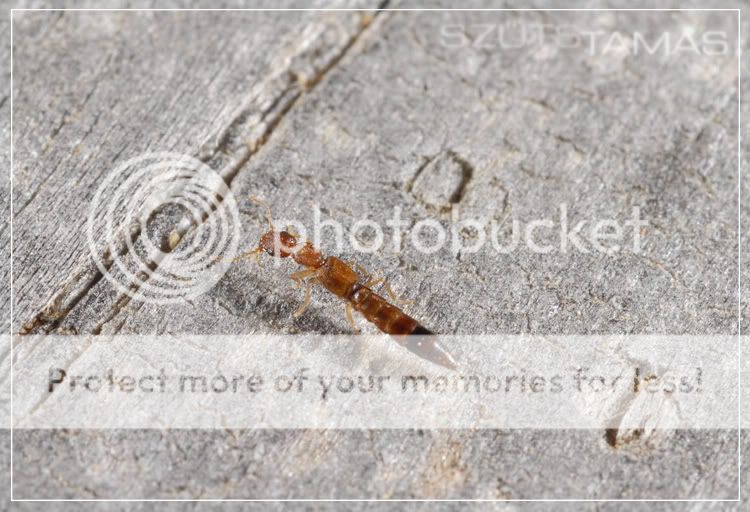 Staphylinidae: Aleocharinae? 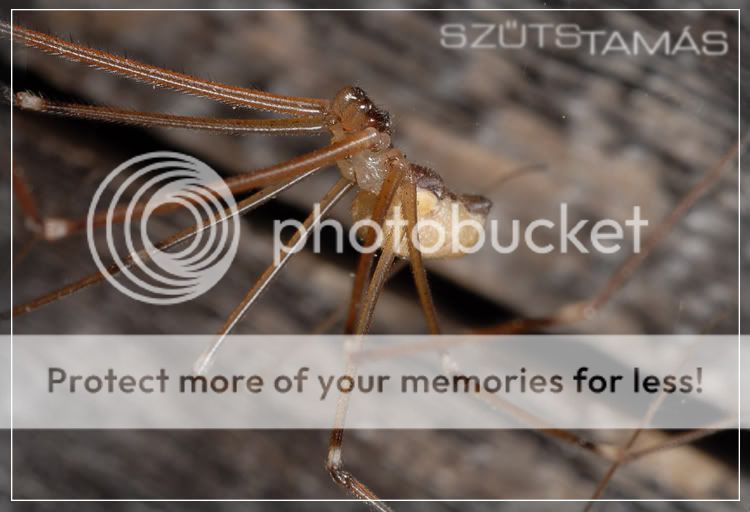 Pholcidae : sp Pholcus tebygol. 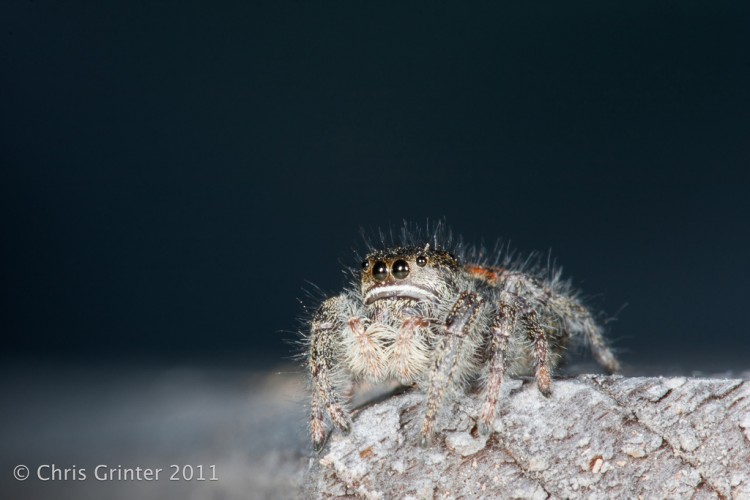 Salticidae: Phidippus sp. Continue reading Blue Oak Ranch Reserve
Gan Chris Grinter, ar Ebrill 6ed, 2011 iawn – ychydig o ymddiheuriadau am beidio â chael delweddau llawn * eto * o'r larfa dan sylw (Byddaf mewn ychydig ddyddiau!). Dros y penwythnos roeddwn allan gyda grŵp o fyfyrwyr Berkeley ar Mount Hamilton a chasglodd yr ymgeisydd PhD Meghan Culpepper ychydig o rywogaethau o Scaphinotus a rhai larfa! So the specimen from Monday was indeed the larvae of a Scaphinotus beetle feasting inside the shell of a native terrestrial snail. This challenge was a hard one since these predatory Scaphinotus larvae are rarely encountered and there are zero images of out there – and none of them feeding. Better luck next time!
For now, here is an undetermined Scaphinotus species. In the coming weeks I will have 4-5 species photographed and identified (by Meghan) – and the larvae will have to be sequenced for species ID. Arhoswch diwnio.
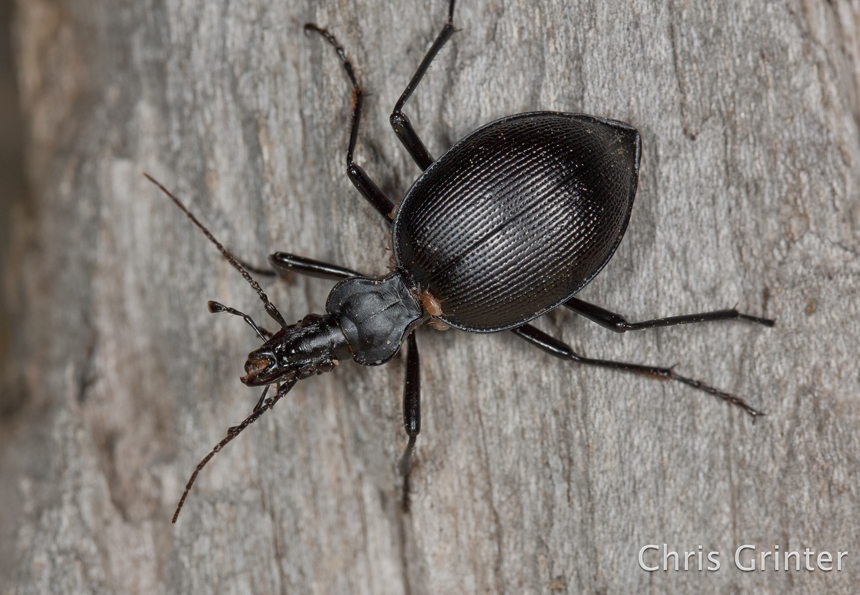
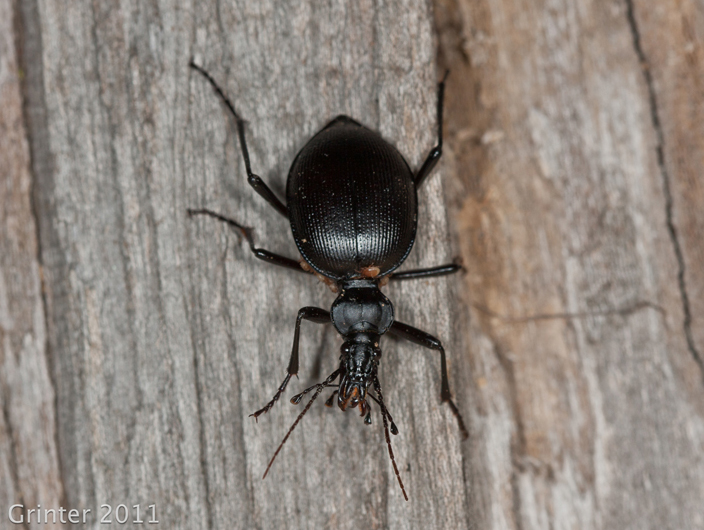
Gan Chris Grinter, ar Ebrill 4ydd, 2011 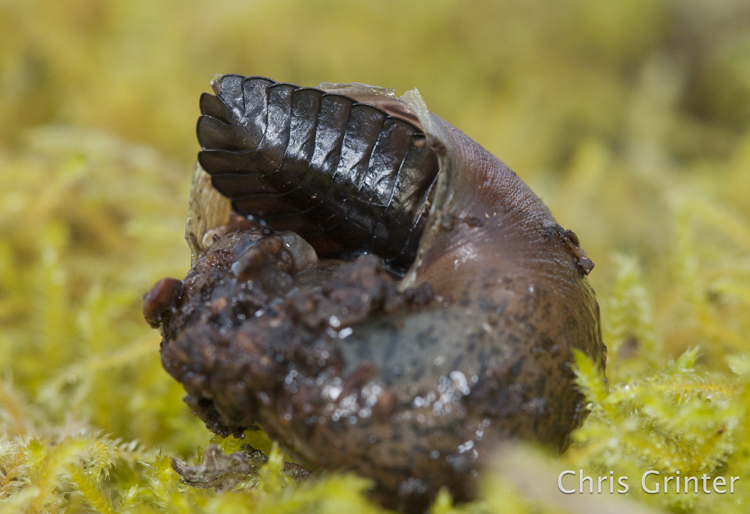
Wedi dod ar draws y boi yma tra allan yn y cae y diwrnod o'r blaen, beth sy'n digwydd yma? Pwyntiau a ddyfarnwyd ar gyfer Archeb / Teulu / Genws – ond ni all hyd yn oed arbenigwyr yn y grŵp hwn ddarganfod y rhywogaeth eto.
(Dylai pawb yn y maes gyda mi ddal eu sylwadau nes bod y dyfaliadau'n dod i mewn!)
Gan Chris Grinter, ar 30 Mawrth, 2011 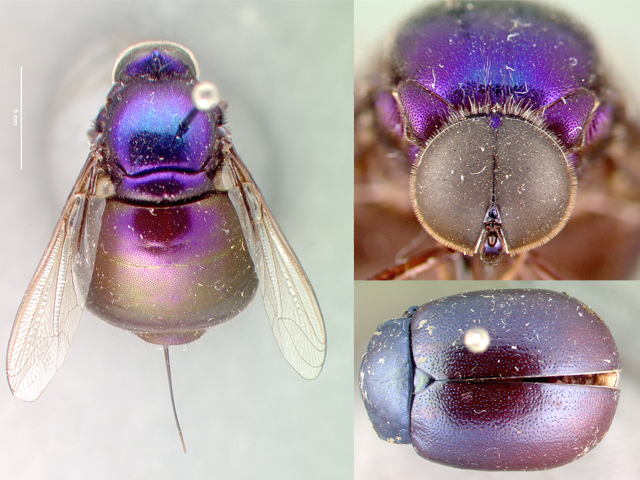 Gwydr klettii: Lluniau erbyn Ebrill Nobile, ACHOS Gwydr klettii: Lluniau erbyn Ebrill Nobile, ACHOS
Am nad oedd y rhan fwyaf o pryfed rhan yn bryfed gallaf gael rhy gyffrous am. Fodd bynnag, y teulu Acroceridae enigmatig yw'r eithriad. 'N annhymerus' yn dechrau rhannu rhai genera diddorol o bryd i'w gilydd – morffoleg y teulu yn hynod amrywiol. Mae'r rhan fwyaf o'm dyddiau'n cael eu treulio yn yr amgueddfa yn rhestru ein casgliad enfawr o dros 16,000 Acorcerids (aka pryfed bach). Efallai nad yw hynny'n swnio'n rhy drawiadol o'i gymharu â theuluoedd eraill mwy niferus (ac y mae yn gwelw mewn cymhariaeth i'r gor 17,500,000 arall sbesimenau sydd gennym yn yr amgueddfa); ond mae'n troi allan i gynrychioli llawer, os nad y rhan fwyaf, o I gyd sbesimenau hysbys i'r teulu cyfan. Tra mae'n debygol bod casgliadau mawr o'r pryfed hyn mewn sefydliadau eraill, gall Academi Gwyddorau California yn hawdd hawlio'r record byth ers derbyn casgliad Dr. Erioed wyf. rholio (sydd o bryd i'w gilydd yn dod i mewn i weithio o'r amgueddfa).
Mae acrocerids yn troi allan i fod yn grŵp eithaf anodd i'w astudio oherwydd pa mor brin ydyn nhw o ran eu natur, eu bioleg parasitoid, a pha mor anodd y gallant fod i'w dal ar yr asgell. Mae eu thoracs mawr yn llawn o gyhyrau sy'n siglo'r pryf drwy'r awyr – felly os na fyddwch chi'n eu dal wrth flodyn rydych chi'n hiraethu am fagl Malaise. Dywedodd Ev un stori wrthyf am ddysgu dal y rhain ar yr adain yn Costa Rica. Rydych chi'n sefyll i lawr y gwynt oddi wrth gydweithiwr yn y maes – cyn gynted ag y bydd rhywun yn clywed rhywbeth sipiwch heibio, rydych yn siglo'n wyllt gan obeithio maglu'r pryf ar hap… mae'n gweithio bob tro. Y pryfed hyn hefyd yw'r unig endoparasitiaid hysbys o bryfed cop llawn-dwf (gall fod cofnod o Tachinid…). Y genws uchod, NeoLasia, yn barasit o tarantwla Theraphosid (rhywbeth tebyg Aphonopelma). Fel larfa mae’r pryf yn gweithio ei ffordd i fyny coesau pry cop ac yn tyllu i’r abdomen lle mae wedyn yn setlo i mewn wrth ymyl ysgyfaint y llyfr ac yn pigo twll anadlu bach.. Yna mae'n aros yn amyneddgar i'r pry cop nesáu at aeddfedrwydd. Gyda tarantwla benywaidd, gallai'r pryfyn fod yn segur am ddegawdau. Yn y pen draw, mae rhywbeth tebyg i'r ffilm Aliens yn digwydd ac mae'r larfa'n bwydo ar organau mewnol y pry cop ac yna'n dod allan i chwiler.. Ond mae darganfod a oes gan bry cop barasit ai peidio heb ddyraniad – felly rhaid cadw casgliadau mawr o bryfed cop byw er mwyn cael cofnodion gwesteiwr. Mae bioleg parasitoid mor cŵl.
Y rbeswm uchod (Gwydr klettii newydd, dienw, rhywogaethau) casglwyd yn 1977 gan Schlinger ger tref Alamos, Mecsico – ar flodau gyda'r model dynwaredol tebygol, chwilen Chrysomelidae (pobl chwilod, unrhyw syniadau y tu hwnt i deulu?).
Gan Chris Grinter, ar Fawrth 24ain, 2011 Better be careful of what you do while out in the countryside. Gall ffermydd fod yn lleoedd peryglus, yn enwedig os ydych chi'n ffotograffydd. Deddfwriaeth arfaethedig yn Florida, dwyn y teitl yn syml “ffermydd”, yn ceisio gwneud ffotograffiaeth neu luniadau i mewn, on or o a farm without explicit written consent a first degree FELONY (hyd at 30 years in prison). What could possibly be the justification for this legislation? Journalist Barry Doyle suggests the good Senator is tightly in the pockets of Agribusiness – looking out for those poor farmers who are targeted by animal rights groups or even worse – human rights groups! I tend to concur, this legislation is a disgusting piece of corruption. It gets pretty bad:
(2) A person who photographs, video records, or otherwise produces images or pictorial records, digital or otherwise, at or of a farm or other property where legitimate agriculture operations are being conducted without the written consent of the owner, or an authorized representative of the owner, commits a felony of the first degree…
I strongly encourage any of my Florida readers to write to Senator Norman and express your absolute disgust in his legislation.
14031 N.. Dale Mabry Blvd.
Tampa, FL 33618
(813) 265-6260
Senate VOIP: 41200
I also encourage everyone else everywhere else to write to your US representative and exclaim your outrage over this possible violation of first amendment rights (only a proposed violation at this moment).
And just for good measure, here is a bad cellphone picture I took while in Oregon with lots of farms.
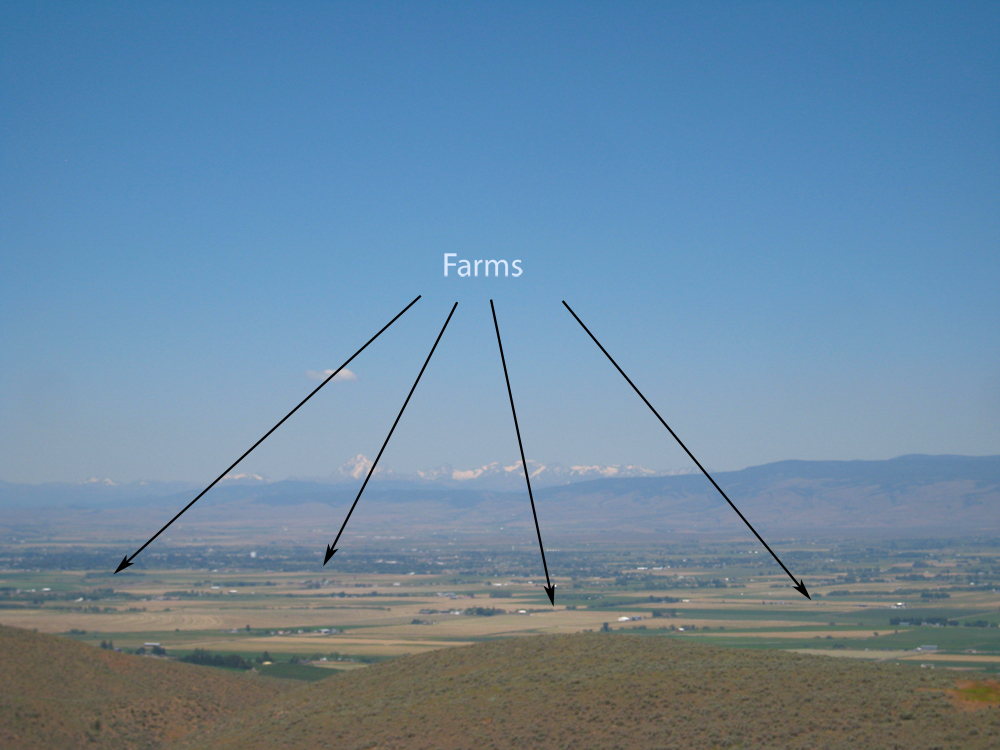
Gan Chris Grinter, on March 22nd, 2011 Usually I come across horrible entomology articles regularly enough that I save a backlog for future series. This hasn’t been the case over the last few weeks, I haven’t come across the normal array of terrible media crud. Maybe I just get jaded and stop looking as carefully – but this week I even came across a moth related correction from the Maui News. They fixed their error, but must have deleted the original article…
And for this week I found yr erthygl hon with the image below. Should be pretty easy to spot the weirdness (maent do at least manage to point out that the moth is Nid the LBAM (light brown apple moth)).
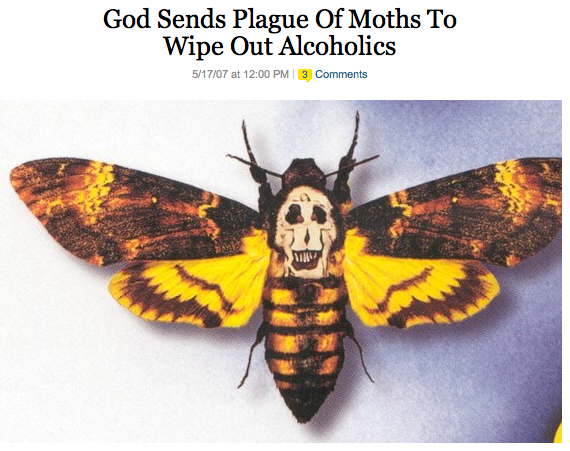
Gan Chris Grinter, ar 18 Mawrth, 2011 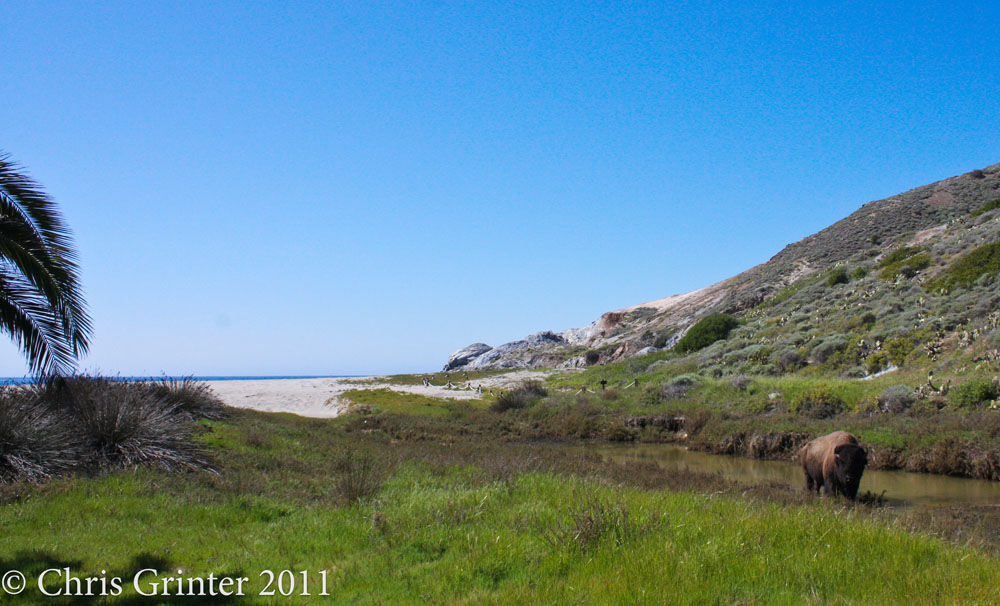
Efallai mai'r unig le yn y byd lle gallwch ddod o hyd i bison Americanaidd (vs.. byfflo) yn sefyll ger traeth wrth ymyl palmwydd. Roedd yr wythnos ar Santa Catalina yn un fendigedig, ac er gwaethaf gwanwyn cŵl gydag ychydig o rew afresymol, gwnaed rhywfaint o gasglu gweddus. Here are just a few amusing images and you’ll notice one thing right away: no fields of wildflowers! As it turns out, almost a century of goat, pig and bison grazing has left mostly grass and cactus on the island. At one point there were over 1000 bison and countless herds of goats; it’s a wonder anything survived at all! Today, there are thankfully only a modest ~200 bison left that are even on birth control (you guessed it, you can’t shoot the damn things since people “love” them – just like the stupid eucalyptus you can’t cut down). In 1924 a small heard of bison were brought over to shoot the movie The Vanishing American. Yn naturiol, the project went over budget, the scene was cut and the animals were let loose instead of paying to return them home. 80 years later and you’re left with an island you can only fight to “conserve” and not restore. Sad fact is that we have no clue what the island actually used to be like. It’s even hypothesized that the endemic island fox (of which we saw 6!) was brought over by indigenous peoples a few thousand years ago from neighboring islands. I guess it’s in our nature to mess with our environment.
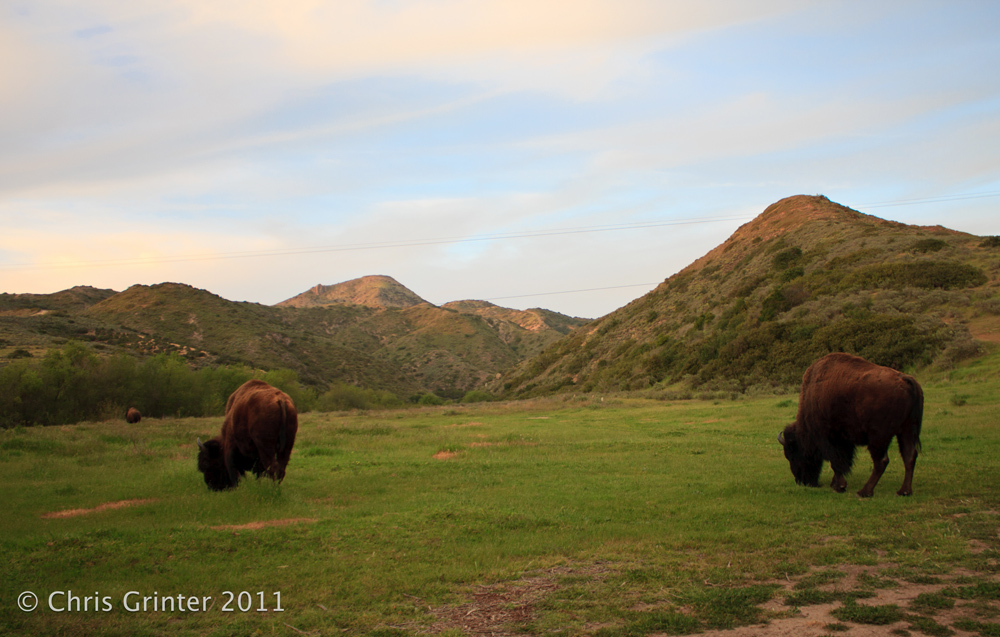
As I was photographing the above, this beast walked up behind me. It wasn’t running, I was!
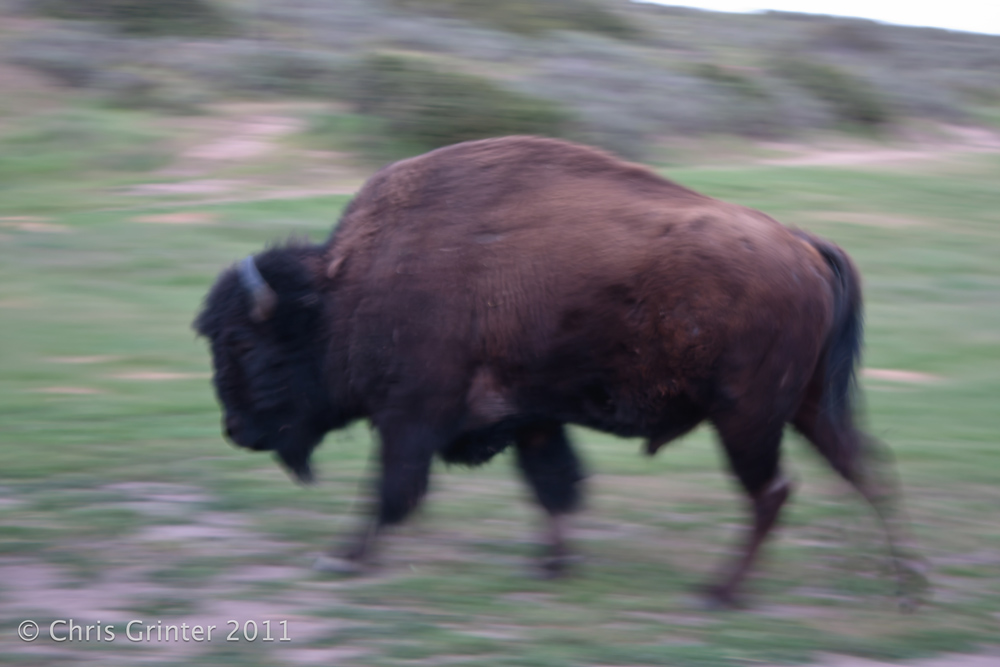
Gan Chris Grinter, ar Fawrth 8fed, 2011 [cetsEmbedGmap src = http://mapiau.google.com/maps?ll=33.393039,-118.416824&sbn=0.359452,0.715485&t=h&z=11 lled=600 uchder=330 marginwidth=0 marginheight=0 frameborder=0 sgrolio=awto]
Bore yfory dwi i ffwrdd am a 10 taith casglu diwrnod i lawr i Ynys Catalina. Rwyf wedi bod yn ddigon ffodus i gael fy ngwahodd i ymuno â Dr. Jerry Powell o UC Berkeley ar arolwg gwyfyn, a dyma fydd fy nhro cyntaf i unrhyw un o'r ynysoedd. Mae Ynysoedd y Sianel yn adnabyddus am eu lefelau uchel o endemistiaeth, ac nid oes neb yn fwy enwog na'r Llwynog Ynys y Sianel. Mae yna hefyd lond llaw o ieir bach yr haf a gwyfynod endemig y byddaf yn gobeithio dod o hyd iddynt, ond o leiaf dwi'n gwybod ei bod hi'n dymor blodau gwyllt ac mae fy nghamera wedi'i beimio.
Mae'n debyg y bydd gennyf ychydig neu ddim mynediad i'r rhyngrwyd tra'n aros ar yr ynys, felly hongian yn dynn am wythnos. Pe bawn i wedi cynllunio ymlaen llaw byddwn wedi trefnu postiadau neu awdur gwadd! Os gwelwch yn dda arhoswch diwnio ar gyfer rhai o fy lluniau cyntaf o'r 2011 tymor maes.
Gan Chris Grinter, ar Fawrth 3ydd, 2011 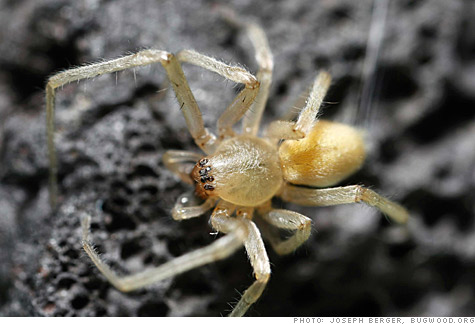
Yn ôl pob tebyg rhywbeth yn y Mazda 6 llinell tanwydd yn gynnes ac yn gwahodd gyfer y sac pry cop melyn, digon fel eu bod yn adeiladu gweoedd dros systemau awyrell y 4 cerbydau silindr (ac nid y 6!). Tybiwyd bod y broblem a “heigiad pry cop” gan y cwmni ceir, ac mae'r llinellau fent rhwystredig yna gall arwain at tanc nwy wedi cracio a'r posibilrwydd o dân.
“Gall math arbennig o pry cop nyddu we yn y llinell canister fent anweddol a gall hyn achosi cyfyngiad o'r llinell”
Hyd yn hyn yn unig 20 achosion yn cael eu cadarnhau, ond y broblem hon yn ddigon toreithiog ei fod wedi arwain at adalw o dros 52,000 sedans! Rwy'n credu ei bod yn amser uchel prif gwmnïau car llogi ymgynghorwyr entomoleg – wedi'r cyfan, byddai fy cadw yn llawer llai na chost y galw yn ôl…
Yr wyf yn ymgynghori â'n tîm o drigolion arachnologists yma yn y ACHOS, ac ymddengys y llun uchod i fod yn pry cop sac. Mae'n rhy anodd dweud o'r ddelwedd, ond mae'n debyg nad methiant tacsonomig egregious.
|
Amheuaeth
|














